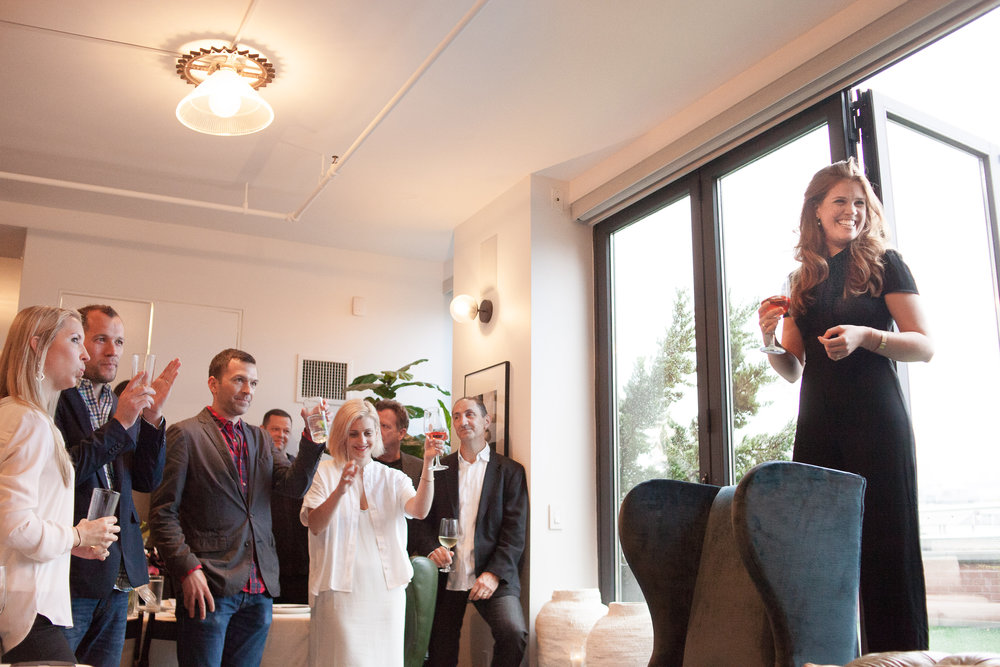Earlier this month, hardware executives Jennifer Gill Roberts of Grit Labs and Kelly Coyne of Pitch merged their respective firms and announced that they would raise $30M to invest and shepherd groundbreaking AI and robotics companies through the often tumultuous journey from prototype to launch.
We sat down with the two seasoned leaders about their new joint venture, their commitment to investing in women in tech, who they have their eyes on, “bootcampers”, and what (really) exist as dangers in our AI future.

Jennifer Gill Roberts

Kelly Coyne
Can you talk a little about your advisement relationship with big firms, one of your sourcing strategies? What’s in it for the big firms?
We have a number of strategic partners through our past relationships as well as our official Grit advisors. These span several verticals and technology waves. One of the most valuable parts of these relationships is the ability to connect our founders directly with the most innovative minds at large firms, helping them to understand the technology that interests these firms and how they view the acquisitive universe.
You talk about “refining [your portfolio companies’] product focus, assembling their technical teams.” What’s important there for companies to think about when they’re doing this?
It’s all too often that we see founders get extremely excited about a given technology or feature and spend an enormous amount of resources on building that—all before really understanding the features that excite their customers. We help them work through those initial steps of understanding product-market fit and product roadmaps.
In addition, we help them explore what their team structure should look like and urge them to hire only the competencies they need, allowing them to conserve capital in the initial growth stages. Part of this is understanding the core competencies of your team and company vs. what you can outsource. For instance, a B2B robotics company doesn’t necessarily need to hire an in-house product designer pre-launch—whereas, for a consumer company, this would be imperative.
Your strategy of spending more time and energy on fewer portfolio companies, how do you see this benefiting you long-term?
We favor the “conviction” model over a broader “spray and pray” approach largely because of our background as operators as well as seed investors. We know that our hands-on model significantly diminishes the risk of our portfolio. Throughout our careers, we have seen many instances where founders with little operational experience would have had a completely different trajectory had they been tightly partnered with their initial investment firm.
Additionally, understanding and working with our portfolio at this level allows us to be enormous assets when they raise their Series A. We work closely with them throughout the entire process, from building the initial pitch deck to making investor connections.
Why seed-stage?
For a hands-on approach such as ours, we are absolutely the most valuable at this stage. The largest impact we can have on our firms is prior to finalization of product and business model or company launch. Helping companies at this critical juncture is not only thrilling, but also gives us the opportunity to share our “lessons learned” at a time when it really counts.
Additionally, we’ve seen a shift in the hardware seed landscape. Many seed-stage hardware firms have experienced great success in the last few years. This leads many of them to raise larger funds and invest larger amounts in the later stage — shifting their focus from seed and pre-seed. This opens room for new, smaller fund entrants such as ourselves.
Lastly, seed investing brings high returns—both beta and alpha. Early-stage venture outperforms public equities over nearly every time horizon, and often dramatically. The 30-year return on early-stage venture beats the public indices by about 2.5x. The same is true for more recent measures, like three-year returns, as well. Seed stage is like traditional early-stage venture, with an even higher beta.
Kelly, you talk about getting started because you’ve seen so many companies make critical mistakes in the conceptual phase. What kinds of mistakes?
One of the things that I have seen time and again in early-stage firms is the desire to build a product with what I call “the evil triad” – GPS, Wi-Fi and Waterproofing. If one chooses to build a product combining all three of these features, they should add a year onto their estimated timeline – and know quite a bit about advanced shielding techniques.
Another common problem is the ability to properly build a Beta program in a way that allows one to systematically assess results. Sending out 500 units and hoping that customers send un-solicited feedback saying they love it does not a Beta program make.
Where do you see AI in ten years?
The world before and after the entrance of artificial intelligence will be as different as the world before and after the internet. There is no way to even approximate the size of the industry at this point.
One of our favorite topics is our theory that Kelly’s one-year old daughter will never take a drivers test or sit behind a steering wheel – this is one of the reasons that we focus heavily on the transportation vertical. Artificial Intelligence will extend our own physical capabilities and invisibly insert robotics into our lives and bodies in ways that we will find ourselves unable to live without 10 years from now.
One of the most critical things to think about today is how we are teaching these machines and who is teaching them. As many of the top firms focus on robotics and AI that’s intended to interact with human beings on a daily basis, we’ve already seen instances of racism arising. It’s impossible to over-emphasize the importance of having diverse minds around the table. This is a critical juncture for AI.
Who do you have eyes on right now, among women in the AI and robotics space?
Right now, Google is far and away the best example of a company that can see this issue on the horizon. Fei Fei Li and Jai Li were amazing hires, giving Google a strong foothold of intellectual diversity behind their AI program. Additionally, Google wisely had an eye to the value they would receive from having a diverse set of minds when they tapped Anna Patterson to lead Gradient Ventures, their new AI fund. If we were to pick a winner from the big 5 right now, we would have to say that Google is setting itself up nicely.

Jia Li

Fei Fei Li

Anna Patterson
How did you meet and could you tell our readers a bit about how you work together? Remotely, in an office, and with what kind of dynamic?
We met through Women in Hardware, an amazing community of women that was founded by Kate McAndrew, from Bolt. Our offices tend to be collective work spaces either in Menlo Park or San Francisco and we try to be together in person a minimum of 3 days a week.
We see eye to eye on a great many things, and our skill sets complement each other extremely well. While [Jennifer] is clearly stronger in terms of reviewing cap tables and assessing financial risk, [Kelly] can eyeball a prototype and quickly estimate how far they are from launch. Our combined strength definitely lies in analyzing and improving business models and GTM plans.
While we definitely have a very similar sense of humor – our joint gift to ourselves for our launch was matching bags emblazoned with the phrase “Carry yourself with the confidence of a mediocre white man” – one of the closest ways we bond is over our mutual tendency to completely “geek out” over some of the most dry B2B robotics projects possible (think, small detail construction robots).
You’re looking for talent and companies outside of bootcamps. Why aren’t bootcamps attracting more tech expertise, do you think?
Bootcamps are great for creating software generalists, people with a wide variety of skills that could build an app or a website with very little additional resources. This abundance of more general engineers has been the driving force behind the software explosion of the last decade.
However, founding an AI or Robotics firm requires extremely deep domain expertise. This level of knowledge can only be gained by years of experience in a specific knowledge realm, which is why we are seeing the vast majority of robotics start-ups being founded by entrepreneurs that previously worked in large corporate R&D labs or just came out of a top tier PhD program.
Do you have anything to say about the danger of AI and robotics harming people (even while it’s great for businesses and making money) by stealing privacy, agency, understanding of how things really are?
AI is coming. Period. End of story. The continued debate about the inherent dangers is important, but will not slow the rise of this technology. Instead of wringing our hands, we must take steps now to ensure that we are doing everything we can to guard against the very real possibility that this technology will become a problem.
The example we use often is around the Facebook AI. It was told to barter with a twin of itself, and it quickly realized that the English language is terribly inefficient for bartering – so, it created it’s own language. You see, the engineers had forgotten to create the rule that it could only barter in English. The sheer number of loopholes that will exist as we venture down the road of AI are terrifying, to say the least. Our best bet is many diverse minds around the table, thinking through these problems and doing their best to cover all the angles.
All that being said, some of the best business models we have seen are those that plan to use the current workforce to enable a Robotics-As-A-Service model. They are taking the experts in jobs in construction or service and giving them the chance to retrain and scale up with this next generation of tech.










Founders, Investing, Leadership, Startups
VC Firms, Venture Capitalists, Inclusivity, diversity, Amrit Richmond
Amrit Richmond
Comment
Founders, Investing, Leadership, Startups
VC Firms, Venture Capitalists, Inclusivity, diversity, Amrit Richmond
Amrit Richmond
Comment
Founders, Investing, Leadership, Startups
VC Firms, Venture Capitalists, Inclusivity, diversity, Amrit Richmond
Amrit Richmond
Comment
Founders, Investing, Leadership, Startups
VC Firms, Venture Capitalists, Inclusivity, diversity, Amrit Richmond
Amrit Richmond
Comment
This is a very good list of big, small, and medium things VCs can do to make funding and future businesses more fair and inclusive and successful.
Founders, Investing, Leadership, Startups
VC Firms, Venture Capitalists, Inclusivity, diversity, Amrit Richmond
Amrit Richmond
Comment
Founders, Investing, Leadership, Startups
VC Firms, Venture Capitalists, Inclusivity, diversity, Amrit Richmond
Amrit Richmond
Comment